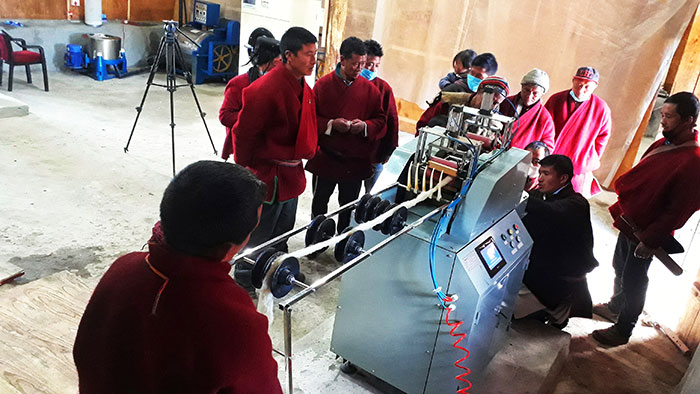Neten Dorji | Trashigang
With the establishment of a medium-scale wool-processing centre in Merak, women do not use traditional tools to convert wool into yarn.
Namgay Dema, 62, said the centre made life easier for them as the machine does all the work. “With the traditional tools like brushes and spindles, it took us about six days to convert a kilogramme of wool to yarn,” she said. “With the machine, it takes an hour only.”

Highlanders in Merak learn how to operate the wool roving machine
The centre was established with funding of Nu 2.1 million from European Union (EU) through Helvetas to procure wool carding and roving machines. The Agency for Promotion of Indigenous Craft’s (APIC) and dzongkhag livestock sector procured other machines to wash wool, de-watering, drying machine and wool opening.
The dzongkhag livestock sector funded Nu 480,000 and APIC funded Nu 493,155.
An association, Buchung Kewa Zangpo Aumsu Deytshen, manages the centre.
APIC’s cluster development Officer, Cheki Dorji, said the centre is expected to improve the wool quality and reduce labour cost for producers in Merak and Sakteng.
He said their objective is also to make the price of wool yarn competitive in international markets without compromising the traditional practice of making yarn. “We don’t provide complete sets of equipment to keep the identity of yarn and indigenous touch.”
Dzongkhag livestock officer, Naina Singh Tamang, said the machines would help highlanders revive sheep rearing practice, increase wool production and enhance income generation.
He said it would also boost the livelihoods of highlanders by selling wool and other woolen products.
Wool was the main raw material to produce traditional dress like teodung, chuba, kango shingkha, and zhamu.
Nima from Gengu village said with the operation of the centre, people started rearing sheep. “It would help us to conserve our traditional dress and encourage other people to rear sheep.”
Highlanders said people almost gave up rearing sheep because of less demand for wool and an increasing number of predators in the community.
They said a kilogramme of wool could now fetch about Nu 300 to 400 now. “People refused to buy our wool earlier because of poor quality,” a highlander said.


